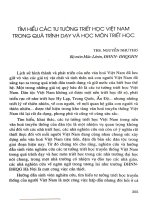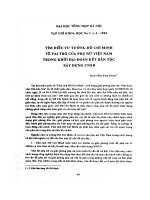DSpace at VNU: Tìm hiểu áp dụng công nghệ Web Ngữ nghĩa vào xây dựng Hệ thống cung cấp thông tin hướng ngữ cảnh
Bạn đang xem bản rút gọn của tài liệu. Xem và tải ngay bản đầy đủ của tài liệu tại đây (242.43 KB, 4 trang )
Tìm hiểu áp dụng công nghệ Web Ngữ nghĩa
vào xây dựng Hệ thống cung cấp thông tin
hướng ngữ cảnh
Explore applying the Semantic Web technology into building Context-based Service system
NXB H. : ĐHCN, 2014 Số trang 73 tr. +
Hoàng Thị Loan
Đại học Công nghệ
Luận văn ThS ngành: Kỹ thuật phần mềm; Mã số: 60480103
Người hướng dẫn: TS. Vũ Thị Hồng Nhạn
Năm bảo vệ: 2014
Keywords: Kỹ thuật phần mềm; Công nghệ WEB ; Web ngữ nghĩa
Content
Ngày nay, với sự bùng nổ về mạng không dây, mạng internet, truyền thông, và các thiết
bị phần cứng nhỏ gọn đã cho ra đời các thiết bị di động thông minh với nhiều tính năng hơn
điện thoại thông thường chỉ có tính năng gọi nghe như trước kia. Với một thiết bị di động nói
chung và điện thoại thông minh nói riêng con người có thể truy cập và nhận thông tin ở bất cứ
thời điểm nào và bất cứ nơi đâu. Cùng với sự phát triển của các dịch vụ web thông thường, thì
các dịch vụ dựa trên ngữ cảnh mà cụ thể là dựa trên vị trí (Location Base Service – LBS) đã và
đang thu hút nhiều mối quan tâm của các nhà nghiên cứu và người dùng. Hệ thống cung cấp
thông tin dựa trên ngữ cảnh thông thường được xây dựng dựa trên nhiều nguồn dữ liệu và
thông tin khác nhau như bản đồ, các đối tượng tham chiếu địa lý, sự di chuyển của người dùng,
thông tin về cá nhân người dùng và mối quan tâm của họ. Để biểu diễn nhiều loại dữ liệu phức
tạp như vậy các nghiên cứu trước đây thường sử dụng mô hình dữ liệu đa chiều. Tuy nhiên sự
nhập nhằng về ngữ nghĩa của thông tin dẫn tới cung cấp thông tin không chính xác cho người
sử dụng là vấn đề vẫn còn tồn tại. Luận văn này tập trung xây dựng hệ thống cung cấp các dịch
vụ thông tin dựa vào ngữ cảnh của người dùng. Trước hết, nghiên cứu khảo sát phân loại dữ
liệu thu thập được từ nhiều nguồn thông tin với mục tiêu phân tách những loại dữ liệu sử dụng
chung trong nhiều miền ứng dụng hay dịch vụ. Điều này giúp các dịch vụ có khả năng chia sẻ
thông tin và đặc biệt dễ dàng tích hợp những dịch vụ mới trong tương lai một cách thuận tiện
dễ dàng hơn. Để giải quyết sự nhập nhằng về ngữ nghĩa của thông tin, nghiên cứu sử dụng
công nghệ Web Ngữ nghĩa và Ontology trong mô hình hóa dữ liệu. Hệ thống được triển khai
theo kiến trúc client – server và có khả năng thực hiện cung cấp thông tin theo hai cơ chế, đó là
đẩy (push) và kéo (pull). Các thuật toán cài đặt các thao tác tìm kiếm thông tin theo các điều
kiện về vị trí, thời gian, cũng như vai trò và mối quan tâm của người dùng cũng được phân tích
và cài đặt. Cuối cùng, một hệ thống thử nghiệm được xây dựng cho phép cung cấp hai dịch vụ
là du lịch và giao thông trong khu vực thành phố Hà Nội. Hệ thống xây dựng cho điện thoại
thông minh với hệ điều hành android và công cụ Protégé để biểu diễn thông tin và ngữ nghĩa.
Kết quả của nghiên cứu hứa hẹn cho sự ra đời của một hệ thống tích hợp và cung cấp nhiều
loại dịch vụ dựa vào vị trí và ngữ cảnh của người dùng một cách tiện lợi và hiệu quả.
Từ khóa: Cung cấp thông tin theo sự kiện và ngữ cảnh, truy vấn theo điều kiện không
gian và thời gian, Web ngữ nghĩa và Ontology.
1
References
Tài liệu tiếng việt
[1]
TS.Vũ Thị Hồng Nhạn, “Nghiên cứu một mô hình cung cấp dịch vụ dựa trên vị
trí”, nghiên cứu khoa học, Đại học Công Nghệ, 2012
Tài liệu tiếng anh
[2]
S. Volz and D. Klinec. Nexus: The development of a platform for location
aware application. In Proceedings of the Third Turkish-German Joint Geodetic Days Towards
A Digital Age, Istanbul, Turkey, 1999.
[3]
K. Cheverst, K. Mitchell, and N. Davies. The role of adaptive hypermedia in a
context-aware tourist GUIDE. Communications of the ACM, 45(5):47–51, 2002.
[4]
S. Poslad, H. Laamanen, R. Malaka, A. Nick, P. Buckle, and A. Zipf. Crumpet:
Creation of user- friendly mobile services personalised for tourism. In Proceedings of 3G 2001
-Second International Conference on 3G Mobile Communication Technologies, 2001.
[5]
R. Oppermann, M. Specht, and I. Jaceniak. Hippie: A nomadic information
system. In Proceedings of the First International Symposium Handheld and Ubiquitous
Computing (HUC), 1999.
[6]
S. Hsi. The electronic guidebook: A study of user experiences using mobile web
content in a museum setting. In Proceedings of the IEEE Intl. Workshop on Wireless and
Mobile Technologies in Education (WMTE), 2002.
[7]
M. Fleck, M. Frid, T. Kindberg, E. O’Brien-Strain, R. Rajani, and M.
Spasojevic. From informing to remembering: Ubiquitous systems in interactive museums.
Pervasive Computing, 1(2):13–21, 2002.
[8]
A. P. Sistla, O. Wolfson, S. Chamberlain, and S. Dao. Modeling and querying
moving objects. In ICDE, pages 422–432, 1997.
[9]
T. W. Yan and H. Garcia-Molina. The SIFT information dissemination system.
ACM Transactions on Database Systems, 24(4):529–565, 1999.
[10]
S. Shekhar and A. Fetterer. Genesis: An approach to data dissemination in
advanced traveler information systems. IEEE Bulletin of the Technical Committee on Data
Engineering, 19(3):40–47, 1996.
[11]
R. Want, A. Hopper, V. Falcao, and J. Gibbons. The active badge location
system. ACM Transactions on Information Systems, 10(1):91–102, 1992.
[12]
A. Ward, A. Jones, and A. Hopper. A new location technique for the active
office. IEEE Personal Communications, 4(5):42–47, 1997.
[13]
J. Hightower and G. Borriello. Location systems for ubiquitous computing.
Computer, 34(8):57–66, 2001.
[14]
T. Brinkhoff. The impact of filtering on spatial continuous queries. In 10th Intl.
Symposium on Spatial Data Handling (SDH 2002), 2002.
[15]
M. Yuan, "Modeling Semantical, Spatial and Temporal Information in a
GIS," Geographic information research: Bridging the Atlantic. Taylor and Francis, London,
pp.334-347, 1997.
[16]
K. Susumu and A. Makinouchi, "Representation of Spatial, Temporal, and
Spatio-temporal Data in the Topological Space Data Model Universe," IPSJ journal abstract,
1999.
2
[17]
D. Pfoser and N. Tryfona, "Fuzziness and Uncertainty in Spatiotemporal
Applications," CH-00-4, Chronochronos, 2000.
[18]
S. Shekar, "Spatial Databases-Accomplishments and Research Needs," IEEE
Transactions on Knowledge and Data Engineering, pp.45-54.
[19]
C.S. Jensen and R.T. Snodgrass, "Temporal Data Management,"
Transaction on Knowledge and Data Engineering, pp.36-43, 1999.
IEEE
[20]
S. Volz and D. Klinec. Nexus: The development of a platform for location
aware application. In Proceedings of the Third Turkish-German .Joint Geodetic Days Towards
A Digital Age, Istanbul, Turkey, 1999.
[21]
1987.
R. Snodgrass, "The Temporal Query Language TQel," TODS, pp.247-298,
[22]
Narin Persad-Maharaj, Sean J. Barbeau, Miguel A. Labrador, Philip L. Winters,
Rafael Pérez and Nevine Labib Georggi, Real-time travel path prediction using gps-enabled
mobile phones, Presented at the 15th World Congress on Intelligent Transportation Systems,
New York, New York, November 16-20, 2008.
[23]
Jingbo Zhou, Anthony K. H. Tung, Wei Wu and Wee Siong Ng, R2-D2: a
System to Support Probabilistic Path Prediction in Dynamic Environments via “Semi-Lazy”
Learning, 2013.
[24]
Brakatsoulas, S., Pfoser, D., and Tryfona, N.: Modeling, Storing and Mining
Moving Objects Databases. In Proc. of the International Database Engineering and
Applications Symposium (IDEAS) (2004) 68-77.
[25]
Bartels, R.H., Beatty, J.C., and Barsky, B.A.: An Introduction to Splines for Use
in Computer Graphics & Geometric Modeling. Morgan Kaufmann Publishers, Inc. (1987).
[26]
Pfoser, D., Jensen, C.J., and Theodoridis, Y.: Novel Approaches in Query
processing for Moving Objects. In Proc. of the conference on Very Large Data Bases (VLDB)
(2000) 395-406.
[27]
Pfoser, D., and Theodoridis, Y.: Generating Semantics-Based Trajectories of
Moving Objects. International Workshop on Emerging Technologies for Geo-Based
Applications, Ascona, Switzerland (2000) 59-76.
[28]
Egenhofer, M.: Reasoning about Binary Topological Relations. In Proc. of the
2 Symposium on Spatial Databases (SSD) (1991) 143-160.
nd
[29]
Berners-Lee, Tim; James Hendler; Ora Lassila (May 17, 2001). “The Semantic
Web”. Scientific American Magazine, 2008.
[30]
Apache Jena: A free and open source Java framework for building Semantic
Web and Linked Data applications (2011), truy cập ngày 02/08/2014, từ
< />[31]
The Dublin Core Metadata Initiative (2003), truy cập ngày 01/08/2014, từ
< />[32]
Ontology
Mapping
(2003),
truy
cập
ngày
01/08/2014,
< />
từ
[33]
OASIS Security Services (SAML) TC (2003), truy cập ngày 01/08/2014, từ
< >.
[34]
Platform for Privacy Preferences (P3P) Project (2007), truy cập ngày
01/08/2014, từ < />
3
[35]
Hewlett-Packard, Freie Universitat, DERI Galway, SPARQL Update A
language for updating RDF graphs W3C Member Submission, 2008.
[36]
L. Aalto, N. Gothlin, J. Korhonen, and T. Ojala, “Bluetooth and WAP Push
Based Location-Aware Mobole Advertising System,” In Proceeding of the 2nd International
Conference Mobile Systems, Applications, and Services, pp. 49 58, 2004.
[37]
Tsoukatos and D. Gunopulos, Efficient Mining of Spatiotemporal Patterns, In
Poceeding On SSTD, LNCS, pp.425-442, 2001.
[38]
Alexander Leonhardi, Uwe Kubach, Kurt Rothermel, Andreas Fritz, Virtual
Information Towers - A Metaphor for Intuitive, Location-Aware Information Access in a
Mobile Environment, 2000.
[39]
Gruber, Th.: Toward Principles for the Design of Ontologies Used for
Knowledge Sharing. Int. Journal of Human-Computer Studies, Vol. 43 (1993) 907-928.
[40]
Frank, A.: Spatial Ontology: A Geographical Point of View. Spatial and
Temporal Reasoning, Kluwer, Dordrecht (1997) 135-153.
[41]
Apache Axis2/Java (August, 2004), truy cập ngày 03/08/2014, tại
< >.
[42]
Ksoap2-android, A lightweight and efficient SOAP library for the Android
platform, truy cập ngày 03/08/2014, tại < />
4









